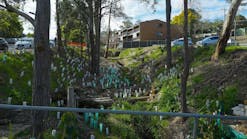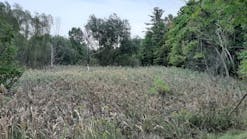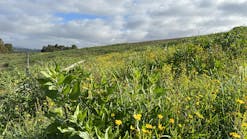No Single “Right Way” for Right of Way Vegetation Management
March 1, 2003
As the proliferation of highway beautification and wildflower programs can attest, roadside vegetation management has changed somewhat in the past decade. When it comes to right of way vegetation management, however the same basic procedures remain: mowing, spraying, or a combination of the two. There are some subtle variations; because of budget constraints, today’s mowing frequency is much lower than that of years ago, and budgets, in addition to increased regulations, have also changed spraying frequencies.In Elk Township, near Topeka, KS, Road Foreman Jim Foster still puts his US Mower boom mower to good use. “I use the boom mower, which some call a ‘bush hog,’rather than spraying,” he says. “As the machine is a mulching mower, it grinds everything into a fine mulch as I go through. To make the process more efficient, I’m cutting it off before it goes to seed at critical life cycles. Our rights of way contain natural vegetation; we really don’t plant much turfgrass. We do some brome grass seeding, and if we can get the area to revert to prairie grass, we are better off. Now we do have a lot of wood coming into play – roadsides will sprout some elm, some oaks, and hedges. Cedars have almost become a noxious weed!”Foster has a set mowing procedure: “After about four years mulch mowing an area, I have gotten rid of most of the ‘nuisance vegetation,’ and then the grass comes back – without spraying. The only time we use chemicals is when we saw something like a small tree or large shrub. Then we spray the stump so it doesn’t grow back. We don’t spray much – in four years we’ve used about 3 quarts of Tordon – because we direct-apply it on the stump only. Big native grasses are mowed about twice a year. We clear cut annually in the fall to keep snow from drifting. Some areas, however, get mowed up to three times a year for safety issues, mostly to keep roadway line-of-sight areas open. We mow from the fence line to the shoulder, which doesn’t hurt the landowner, yet we’re taking care of what we need to.”Foster is responsible for maintaining about 70 mi. of road, many of them rural gravel roads. “I have to grade the roads, clean the ditches, do the mowing, inspect equipment, and all the other management things that go with that,” he relates. “We do a little contracting with the city for some spraying. Cost- and time-savings is a big priority. State funds are almost insignificant: less than 10% of our budget. The rest of our operating budget comes from property taxes.“We have very little trouble with property lines, if we ever need to cross them,” he notes. “The township controls the right of way, which ranges from 30 to 60 feet, and that includes the road; anyone who puts anything there does so at their own risk. It’s a matter of public safety and needs.” Elk Township employs a 60-in. deck boom mower with a 20-ft. reach. “It’s mounted behind a New Holland TS 100 tractor with creeper gears,” Foster explains. “You need a set of creeper gears for the tractor to enable you to mow 17 feet per minute. The design of the mower deck and the cutter bar determines how well this happens. Since I do mulching, the mower has enough shielding so what’s mowed stays in there and gets chopped up. I spent almost two years researching mowers to find one that would do the job – I mow trees up to 5-inch diameter and make them into mulch. This US Mower has lived up to what we expected, which is essential because I also have to grade the roads, et cetera. I don’t have all year to mow!”The Weed-Free Zone
Meanwhile, at the other end of Topeka, Shawnee County (KS) Noxious-Weed Director John Kabus uses spraying to meet the specific goal for his maintenance projects: no weeds – anywhere. “There’s a noxious-weed department in every county,” he points out. “We’re also less tolerant of tree species in our rights of way, as opposed to other states. However, the state DOT [department of transportation] putting in wildflowers and native grasses – little bluestem, some big bluestem, some switchgrass, mostly tall fescue – has changed how we deal with weeds and the products we use. Weeds are prolific and hard to kill. We use different products in urban areas than we do in rural areas. We use selective herbicides for broadleaves; we never want a bare spot, so we rarely use RoundUp.”Spraying requires finesse. “We keep cautious about drift. We don’t go out on windy days, or we use a few granular products on those days. We also use granulars on park areas – people don’t seem as worried about granular chemicals as they are about liquids,” Kabus relates.“We are not extensively right of way managers; we’re concerned about weeds wherever they are. The majority of our job, which is funded through property taxes, is working with private property. We have no problems with private land access – 99% of folks are glad we’re there. Any vegetation management on roadsides [is paid for by] the counties or the township, state, drainage district, or whatever has jurisdiction. We will do contract work for other government agencies; of course, some sort of taxes pays for it. We’re also grateful for landowners who help us fight weeds, and we will sell herbicides to them at a lesser rate,” he says.Shawnee County, home to around 120,000 people, contains Topeka, the state capital, and is half urban, half rural. In such an area, with its mix of traffic congestion and rural backroads with higher speed limits, concerns about safety are an everyday thing. “Roadways are dangerous,” Kabus admits. “We also do work on railroad areas. We won’t send an applicator alone. We always have an observer to watch the traffic. Even though our vehicles are a good size – in rural areas we use a retrofitted pickup, and for smaller urban areas we use a jeep-type small truck – drivers sometimes don’t see our crews.”The weed patrol also maintains the county’s stormwater drainage. “The Kansas River runs through our county. There’s a levee system because of the river; the government owns all that property. We control weeds there, and [the government is] very interested in brush control,” Kabus adds. “Others have the mowing rights. Any levees covered with boulders, or riprap basketball-size rocks, there’s to be no vegetation there!”In the Ditch
In many rural and semirural areas, part of the right of way contains a stormwater drainage ditch. Maintaining this area calls for a specific tool. Ditch Master of Chehalis, WA, manufactures machines for cleaning out ditches. A retractable cleaning arm with a rotating auger removes trash and debris to improve water flow. The Ditch Master 400 is often used for cleaning ditches along roadways in subdivisions, where homeowners are likely to perform maintenance right up to the roadway, and creates a rounded ditch bottom that can be mowed. “The machine doesn’t disturb the backslope like a backhoe does,” notes Charlie Ford, Ditch Master’s president. The company not only sells the machines nationwide but also sometimes performs the work for various municipalities. “For example, I go to Bellevue [Washington] and clean its ditches,” relates Ditch Masters’s Ray Beck. “Where a bucket could do about 300 feet a day, a Ditch Master lets me clean out about 2,500 feet a day.”“Ditch Master has been cleaning our drainage ditches – about 800 or 1,000 miles of them – for about 15 years,” points out Jim Morris, Bellevue’s Surface Water Utilities crew leader. “The task is done once a year, in the first quarter. Of course, our field ops might also make a list of other ditches that need care during other seasons. The machine does not disturb the vegetation on the sides of the ditches. Beck cleans the city right of way only; the ditches are all grass swales that drain into lakes on either side of us. We don’t treat that water in any way. If there’s just dirt in there, rather than grass, we put hay bales in the ditches to keep the runoff clean.”After cleanout, Bellevue hydroseeds the ditches with perennial rye. “We usually do this in the dry season and contact someone to water the ditches, to keep the grass growing,” Morris explains. “We don’t mow; homeowners do the mowing, as the ditch is at the end of their yards. As for maintenance, we use no herbicides – neither the state nor the county allows it. Residents are asked not to put anything in the ditches. We don’t like it when they put chemical fertilizers on their lawn, but some do – we hope they’re not using pesticides too.”Mow or Spray? Depends on the Day
In north central Indianapolis, Clyde Mason, landscape supervisor of Greenfield District for Indiana’s DOT, uses a two-pronged attack on vegetation. “We do just the roadsides; we don’t do anything under power lines. We take care of all interstates, secondary, and primary state roads in our area – no county roads,” Mason states. “We usually plant KY 331 fescue, and allow it to grow to 14 or 15 inches before we cut it to 5 inches. We mow in May before Memorial Day; in June, we do a full-width mow everywhere, and we mow a 15-foot strip in urban areas in August. Of course, where we’re getting forbs, flowers, or native grasses, we won’t mow, and we’ve been actively planting such items.”Indiana DOT does some spraying, where it’s allowed. Mason explains, “We can’t spray chemicals not labeled for certain areas. For example, we can’t use RoundUp on rights of way, only RoundUp PRO. Most products have a right of way label; if the label says it can’t be used around water, we won’t use it. On the other hand, a product like Rodeo is approved for aquatic use. We would use it for drainage ditch or any rainwater runoff. In essence, every foot of right of way we have is stormwater management, because it all goes to runoff. In some areas we’re building retention ponds – near rest stops, for example – so runoff is dosed out to the system at a slower rate. We don’t treat the runoff chemically; we do infiltration treating only, although in some places we have oil/water separators.”Some Vegetation Is Plateau-ed
Instead of mowing, or spraying plants stone dead, there are now other alternatives. One, an herbicide from BASF Corporation called Plateau, offers “seed-head suppression.” Because the height of many grasses and plants increases dramatically (sometimes called, appropriately enough, “bolting”) only during flower and seed formation, limiting a plant’s ability to set seed would also limit its height, reducing the need for mowing.ASF maintains that seed-head suppression offers many advantages. Shorter grasses would offer motorists greater safety due to better driving visibility and the reduced possibilities of mowers throwing debris onto cars or the road. Less vegetation and undergrowth makes less cover for birds and animals, who might not venture close to the road, resulting in fewer wildlife-versus-car accidents. Seed-head suppression, by reducing the need to mow, would not only reduce vegetation management costs but also would eliminate some risks for the mower operators.When applied, Plateau is absorbed through the plant’s leaves, stems, and roots and travels rapidly throughout the plant, accumulating in the meristematic regions (areas of the plant that perpetuate formation of new tissue). Depending on the application strength, the herbicide not only can suppress seed formation but also can effect a “complete kill.” A killing dose for Johnson grass, for example, requires 8-12 oz./ac. For seed suppression on Bahia grass, only 2-6 oz./ac. is used.illy Thompson, vegetation control manager for the Department of Public Works of Baton Rouge/Parish of East Baton Rouge, LA, uses the product as part of his program. “The only thing we’re spraying now is roadsides,” he reports. “We do some residential, like medians, but if the homeowner is taking care of the property, we don’t spray it. When we first started our spraying program, we had a couple of complaints – now that they know, homeowners say, ‘Please spray me,’ although we can’t.”Thompson’s crew has few restrictions, although he notes, “Strict attention is paid to the weather. If it’s raining, or during winds of more than 10 miles per hour, we don’t spray. We use Plateau just about anywhere – even where cattle graze, we can spray and they can eat the same day.”Although it combats some plants, Baton Rouge has a vegetation preference: “What we’re trying to do is release Bermuda grass – it looks good, spreads well, and helps fight erosion,” Thompson explains. “We still do some mowing, but we’re trying to back off from it, to get the best use of taxpayers’ money.”Thompson used the herbicide for the first time in 2002. The spraying is done from a large truck rather than with handheld sprayers. “The rate we use, about 2% to 4%, allows Bermuda grass to grow but not others. If we went to 8%, it would damage Bermuda grass also; it stunts the grass but doesn’t kill it for about eight weeks. We probably sprayed 1,800 acres in 2002; I want to get that number up to 4,000 acres – each year I want to increase the budget. Over a three-year period, I should get it up to at least 3,000 acres,” he says. “We’re not yet saving money in payroll – people are still out there – but we’re saving on wear and tear of equipment. We can spend $50,000 a year just on bearings for the tractors, and [with spraying] we won’t be paying for windshields broken by a mower-thrown rock.”Thompson has no concerns about using the herbicide with Louisiana’s high water table. “We tested it for several years – also tried out a couple of companies’ products on test plots. I wouldn’t mind using it in my own yard, and I have grandkids who play there.”
In many rural and semirural areas, part of the right of way contains a stormwater drainage ditch. Maintaining this area calls for a specific tool. Ditch Master of Chehalis, WA, manufactures machines for cleaning out ditches. A retractable cleaning arm with a rotating auger removes trash and debris to improve water flow. The Ditch Master 400 is often used for cleaning ditches along roadways in subdivisions, where homeowners are likely to perform maintenance right up to the roadway, and creates a rounded ditch bottom that can be mowed. “The machine doesn’t disturb the backslope like a backhoe does,” notes Charlie Ford, Ditch Master’s president. The company not only sells the machines nationwide but also sometimes performs the work for various municipalities. “For example, I go to Bellevue [Washington] and clean its ditches,” relates Ditch Masters’s Ray Beck. “Where a bucket could do about 300 feet a day, a Ditch Master lets me clean out about 2,500 feet a day.”“Ditch Master has been cleaning our drainage ditches – about 800 or 1,000 miles of them – for about 15 years,” points out Jim Morris, Bellevue’s Surface Water Utilities crew leader. “The task is done once a year, in the first quarter. Of course, our field ops might also make a list of other ditches that need care during other seasons. The machine does not disturb the vegetation on the sides of the ditches. Beck cleans the city right of way only; the ditches are all grass swales that drain into lakes on either side of us. We don’t treat that water in any way. If there’s just dirt in there, rather than grass, we put hay bales in the ditches to keep the runoff clean.”After cleanout, Bellevue hydroseeds the ditches with perennial rye. “We usually do this in the dry season and contact someone to water the ditches, to keep the grass growing,” Morris explains. “We don’t mow; homeowners do the mowing, as the ditch is at the end of their yards. As for maintenance, we use no herbicides – neither the state nor the county allows it. Residents are asked not to put anything in the ditches. We don’t like it when they put chemical fertilizers on their lawn, but some do – we hope they’re not using pesticides too.”Mow or Spray? Depends on the Day
In north central Indianapolis, Clyde Mason, landscape supervisor of Greenfield District for Indiana’s DOT, uses a two-pronged attack on vegetation. “We do just the roadsides; we don’t do anything under power lines. We take care of all interstates, secondary, and primary state roads in our area – no county roads,” Mason states. “We usually plant KY 331 fescue, and allow it to grow to 14 or 15 inches before we cut it to 5 inches. We mow in May before Memorial Day; in June, we do a full-width mow everywhere, and we mow a 15-foot strip in urban areas in August. Of course, where we’re getting forbs, flowers, or native grasses, we won’t mow, and we’ve been actively planting such items.”Indiana DOT does some spraying, where it’s allowed. Mason explains, “We can’t spray chemicals not labeled for certain areas. For example, we can’t use RoundUp on rights of way, only RoundUp PRO. Most products have a right of way label; if the label says it can’t be used around water, we won’t use it. On the other hand, a product like Rodeo is approved for aquatic use. We would use it for drainage ditch or any rainwater runoff. In essence, every foot of right of way we have is stormwater management, because it all goes to runoff. In some areas we’re building retention ponds – near rest stops, for example – so runoff is dosed out to the system at a slower rate. We don’t treat the runoff chemically; we do infiltration treating only, although in some places we have oil/water separators.”Some Vegetation Is Plateau-ed
Instead of mowing, or spraying plants stone dead, there are now other alternatives. One, an herbicide from BASF Corporation called Plateau, offers “seed-head suppression.” Because the height of many grasses and plants increases dramatically (sometimes called, appropriately enough, “bolting”) only during flower and seed formation, limiting a plant’s ability to set seed would also limit its height, reducing the need for mowing.ASF maintains that seed-head suppression offers many advantages. Shorter grasses would offer motorists greater safety due to better driving visibility and the reduced possibilities of mowers throwing debris onto cars or the road. Less vegetation and undergrowth makes less cover for birds and animals, who might not venture close to the road, resulting in fewer wildlife-versus-car accidents. Seed-head suppression, by reducing the need to mow, would not only reduce vegetation management costs but also would eliminate some risks for the mower operators.When applied, Plateau is absorbed through the plant’s leaves, stems, and roots and travels rapidly throughout the plant, accumulating in the meristematic regions (areas of the plant that perpetuate formation of new tissue). Depending on the application strength, the herbicide not only can suppress seed formation but also can effect a “complete kill.” A killing dose for Johnson grass, for example, requires 8-12 oz./ac. For seed suppression on Bahia grass, only 2-6 oz./ac. is used.illy Thompson, vegetation control manager for the Department of Public Works of Baton Rouge/Parish of East Baton Rouge, LA, uses the product as part of his program. “The only thing we’re spraying now is roadsides,” he reports. “We do some residential, like medians, but if the homeowner is taking care of the property, we don’t spray it. When we first started our spraying program, we had a couple of complaints – now that they know, homeowners say, ‘Please spray me,’ although we can’t.”Thompson’s crew has few restrictions, although he notes, “Strict attention is paid to the weather. If it’s raining, or during winds of more than 10 miles per hour, we don’t spray. We use Plateau just about anywhere – even where cattle graze, we can spray and they can eat the same day.”Although it combats some plants, Baton Rouge has a vegetation preference: “What we’re trying to do is release Bermuda grass – it looks good, spreads well, and helps fight erosion,” Thompson explains. “We still do some mowing, but we’re trying to back off from it, to get the best use of taxpayers’ money.”Thompson used the herbicide for the first time in 2002. The spraying is done from a large truck rather than with handheld sprayers. “The rate we use, about 2% to 4%, allows Bermuda grass to grow but not others. If we went to 8%, it would damage Bermuda grass also; it stunts the grass but doesn’t kill it for about eight weeks. We probably sprayed 1,800 acres in 2002; I want to get that number up to 4,000 acres – each year I want to increase the budget. Over a three-year period, I should get it up to at least 3,000 acres,” he says. “We’re not yet saving money in payroll – people are still out there – but we’re saving on wear and tear of equipment. We can spend $50,000 a year just on bearings for the tractors, and [with spraying] we won’t be paying for windshields broken by a mower-thrown rock.”Thompson has no concerns about using the herbicide with Louisiana’s high water table. “We tested it for several years – also tried out a couple of companies’ products on test plots. I wouldn’t mind using it in my own yard, and I have grandkids who play there.”





